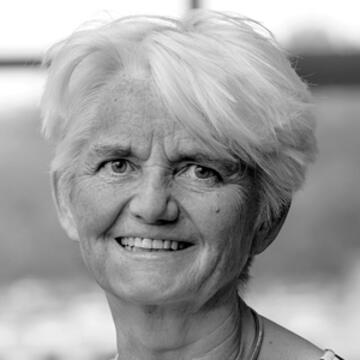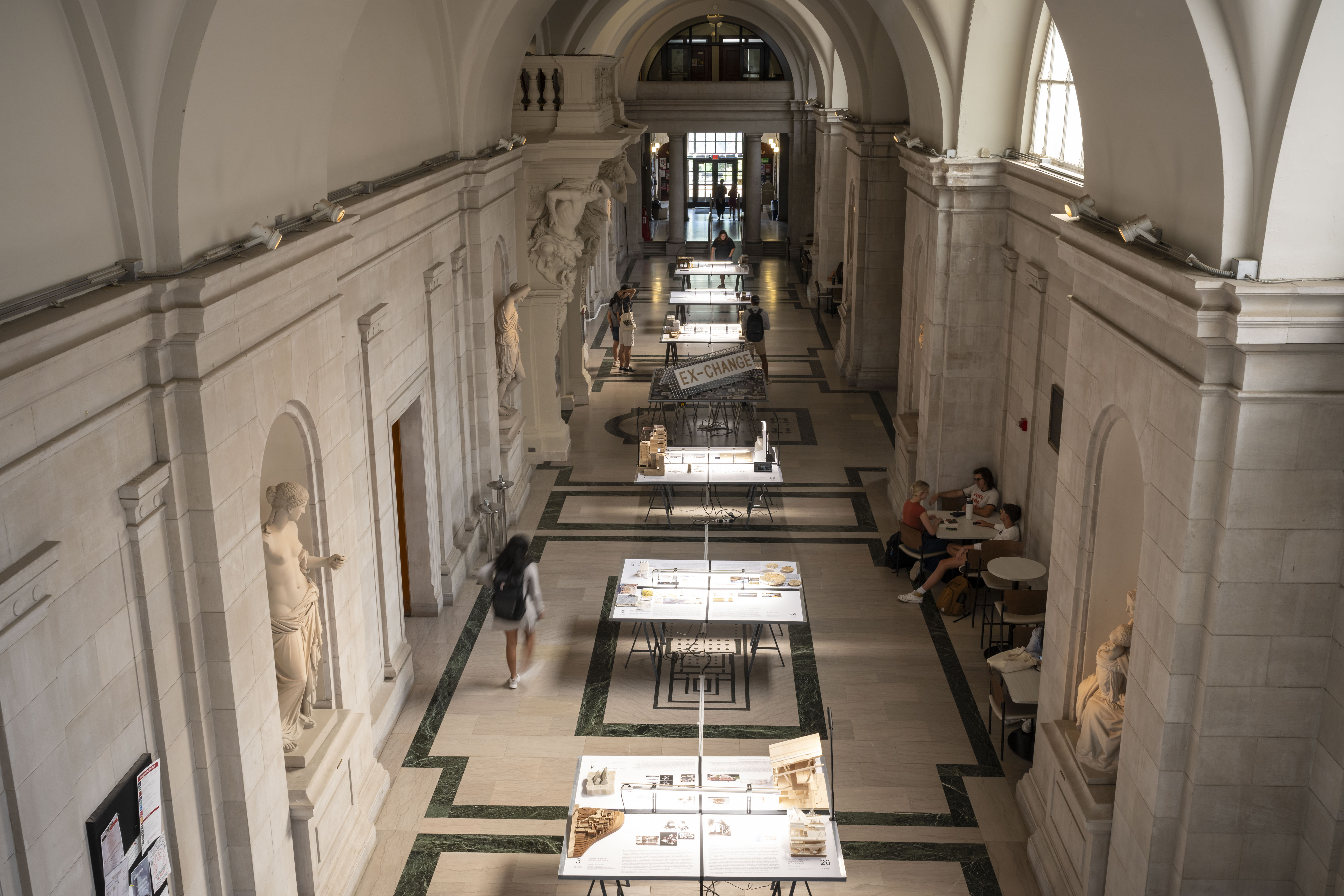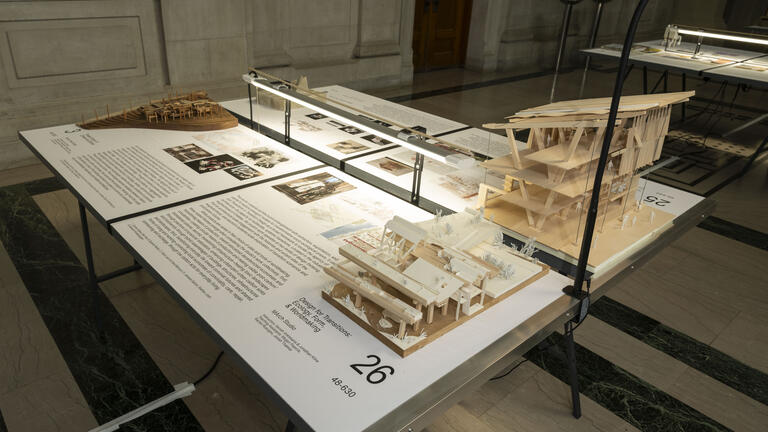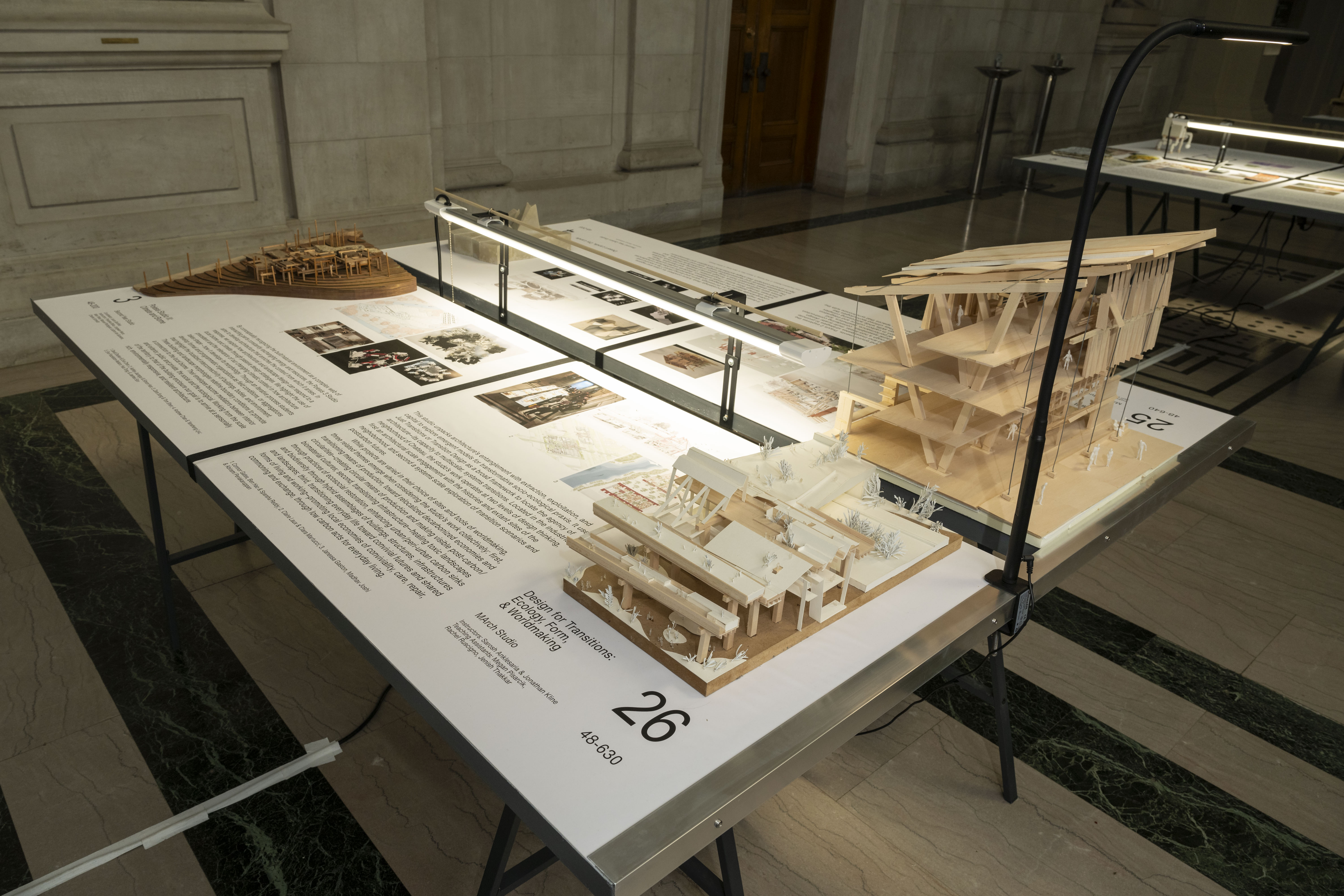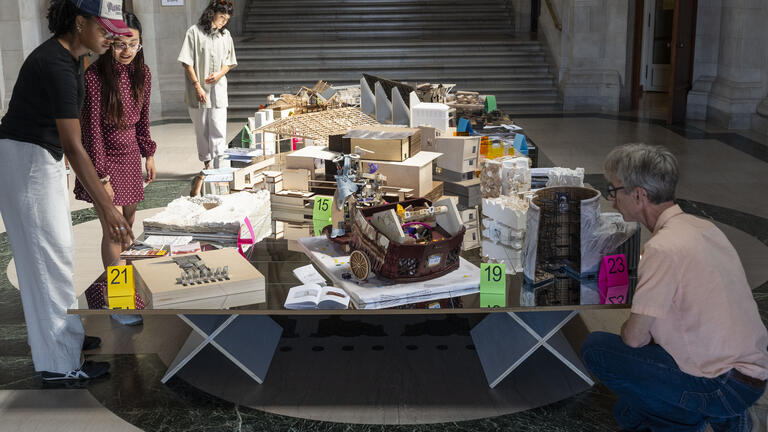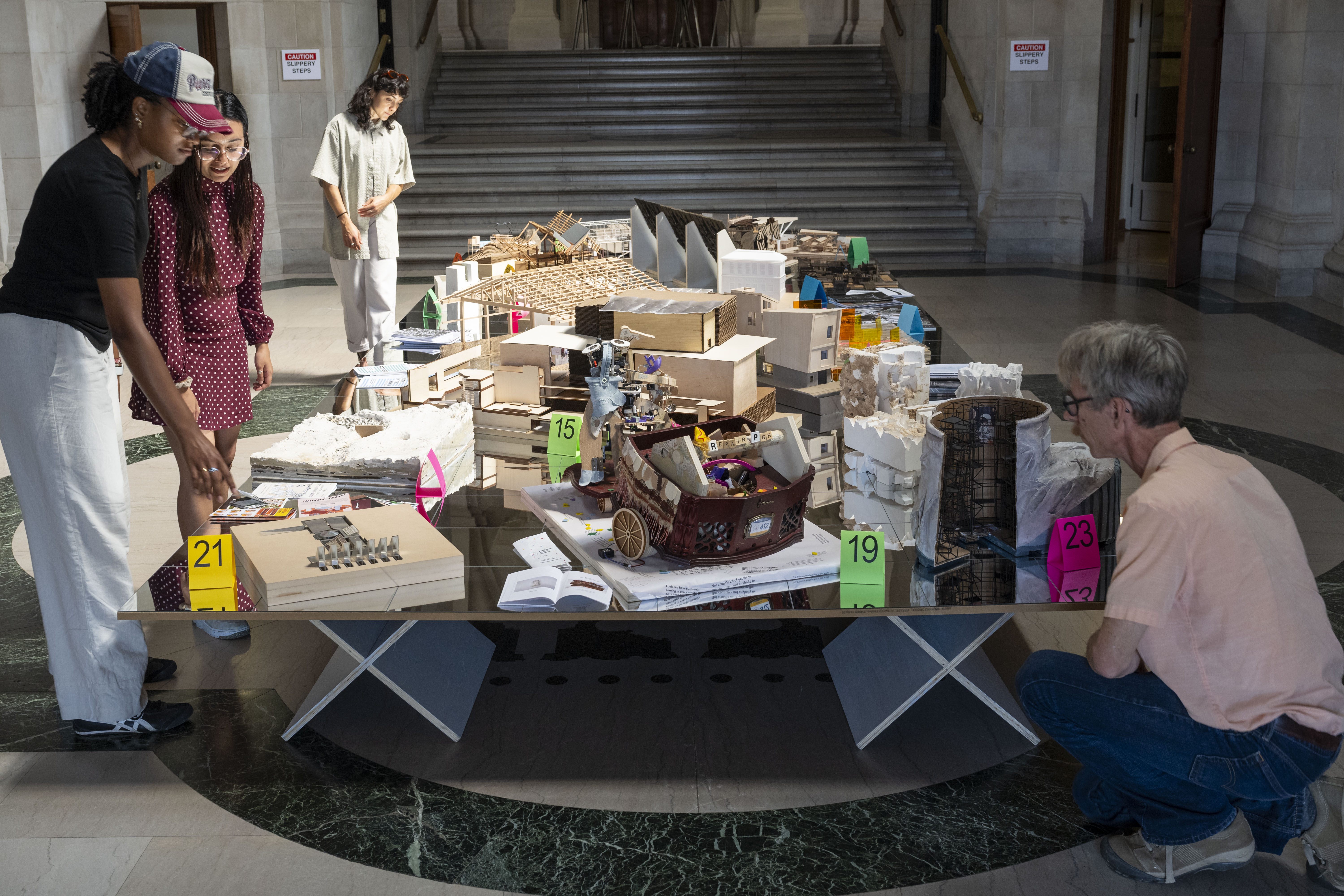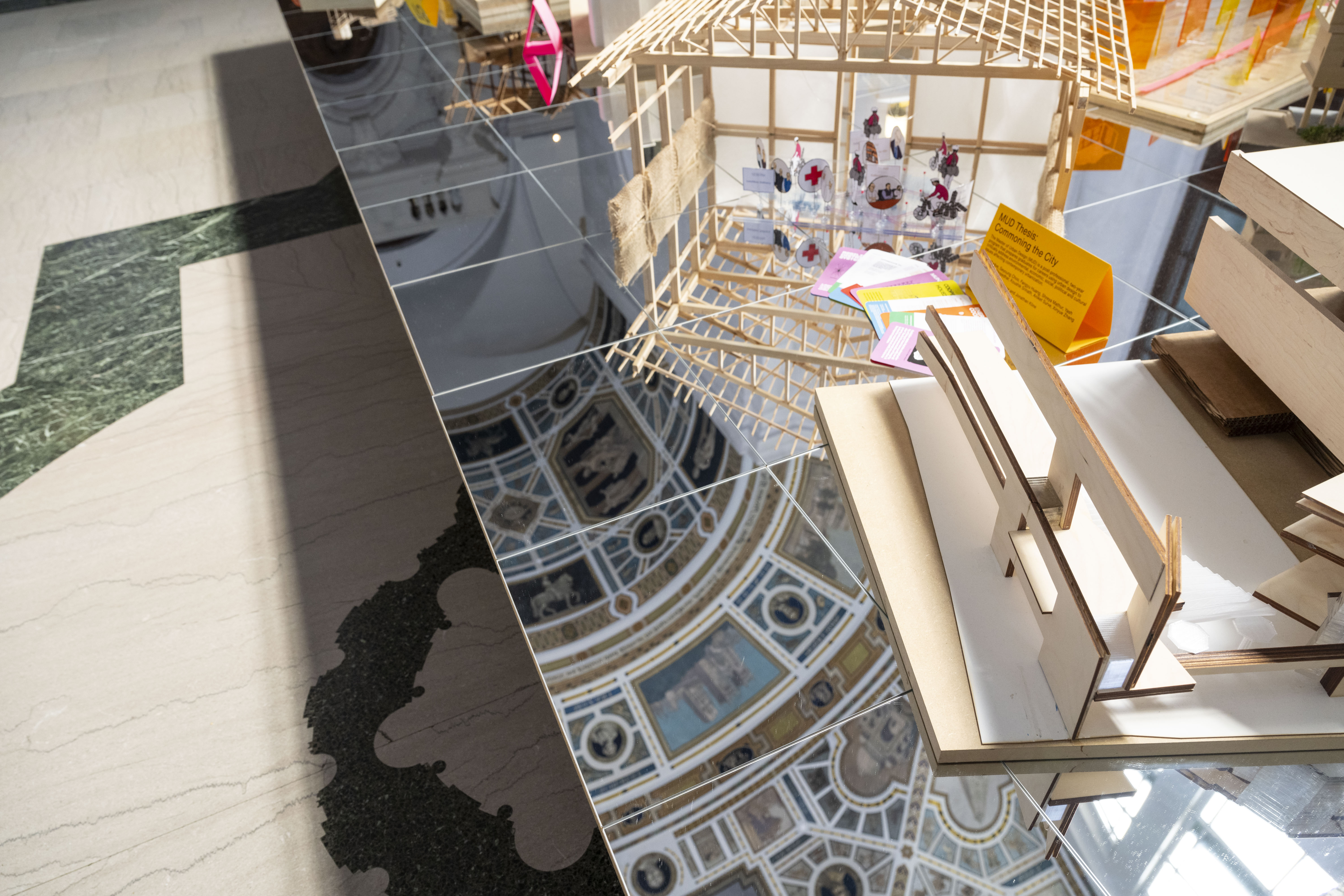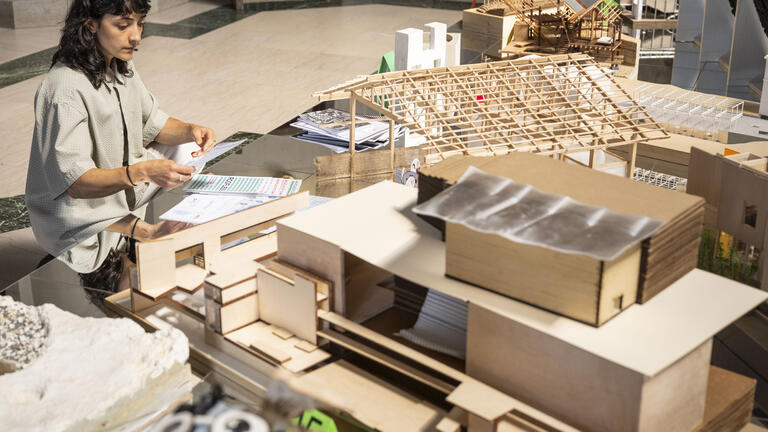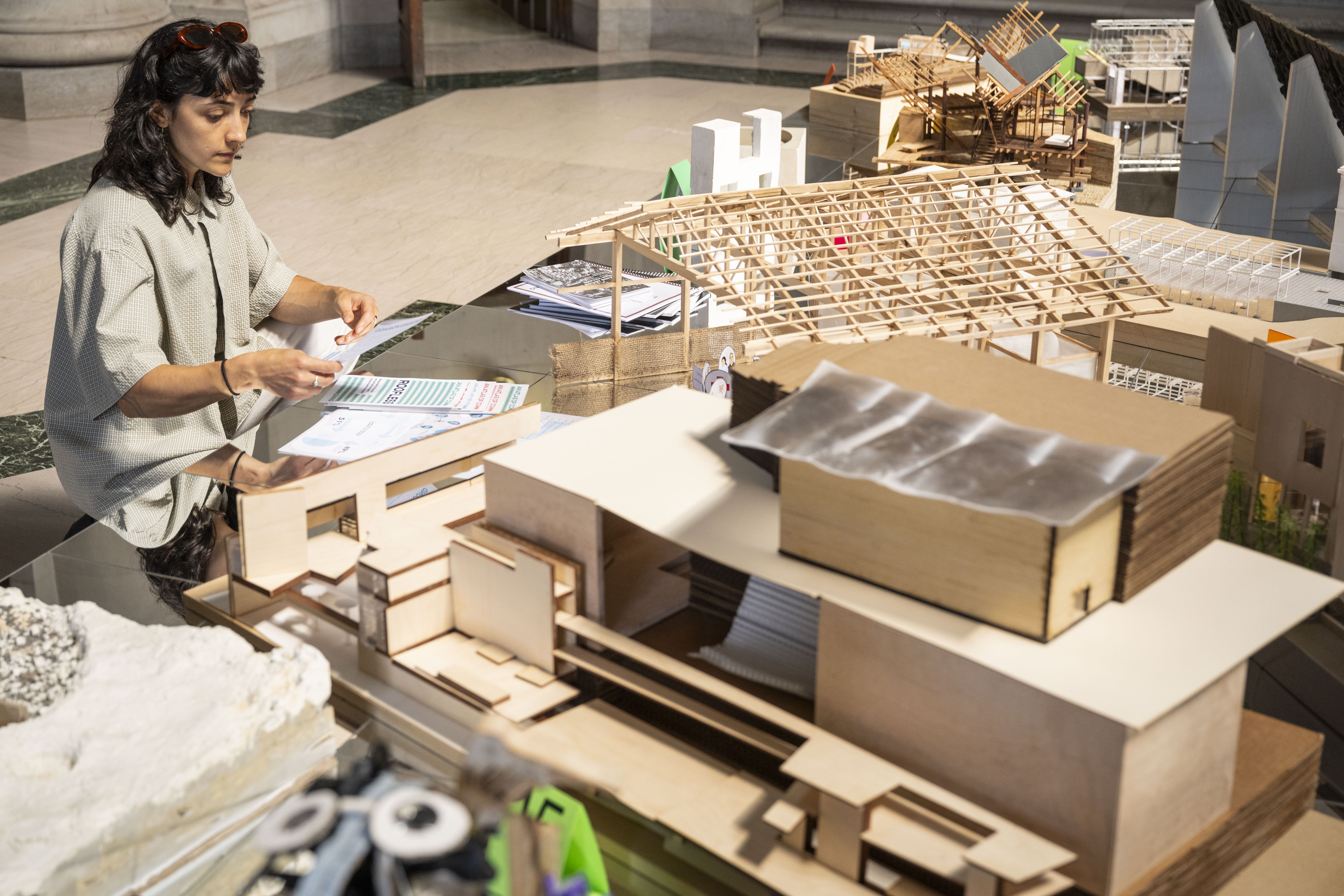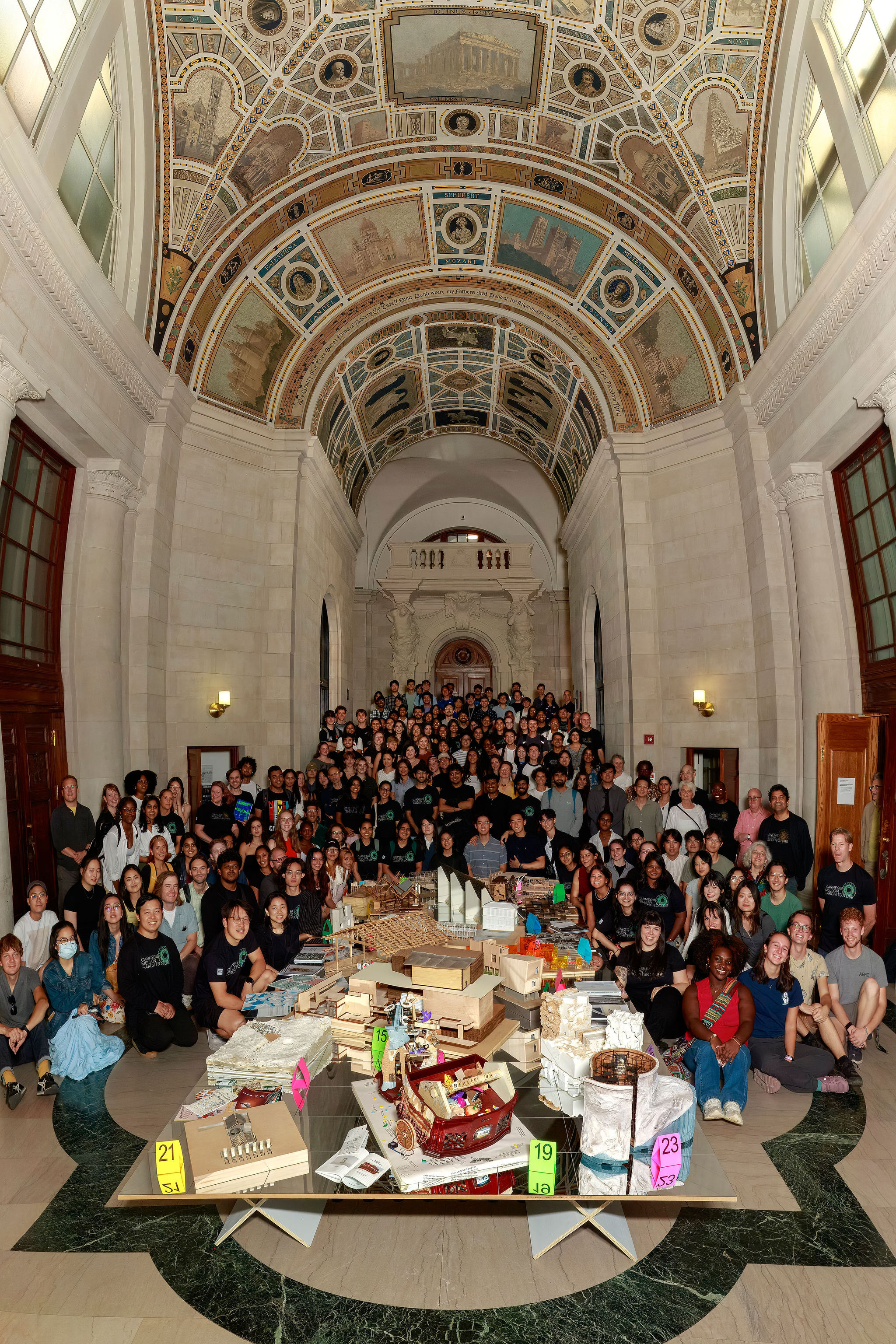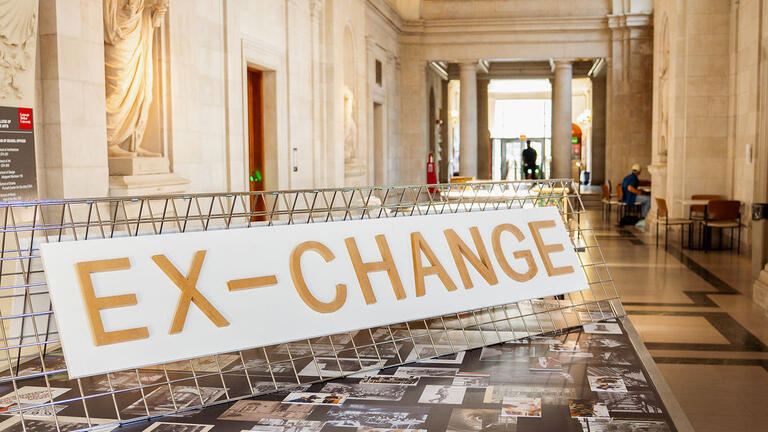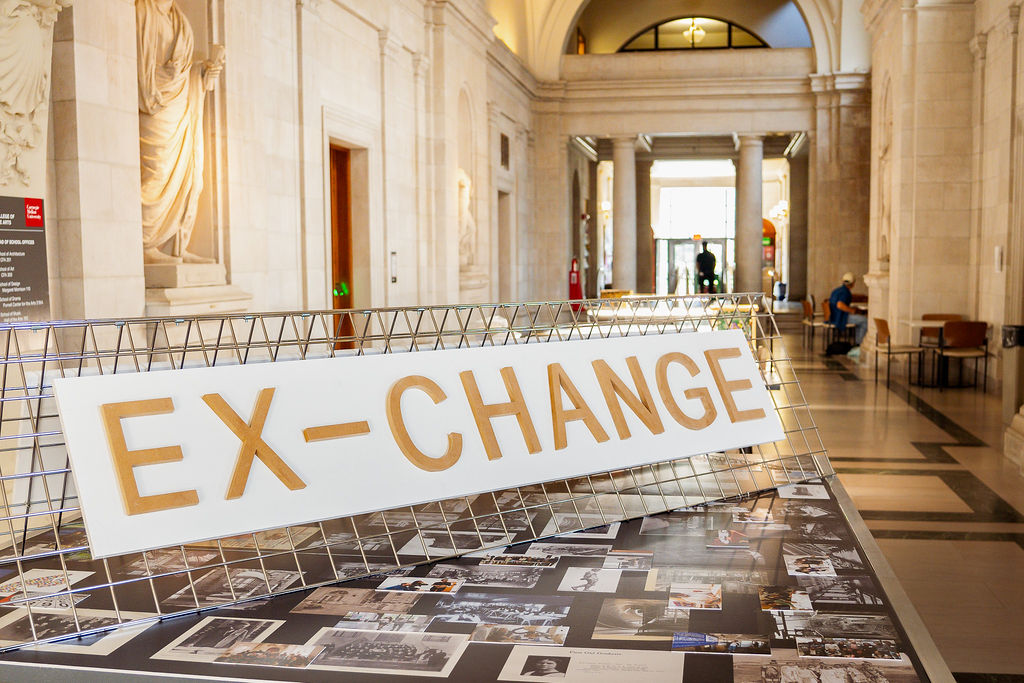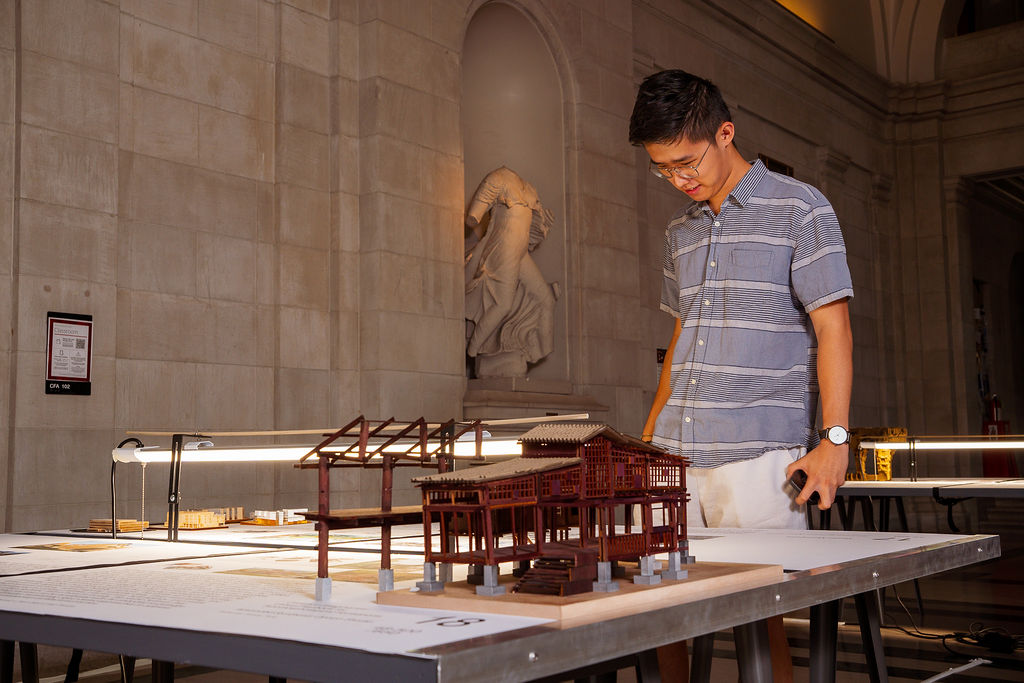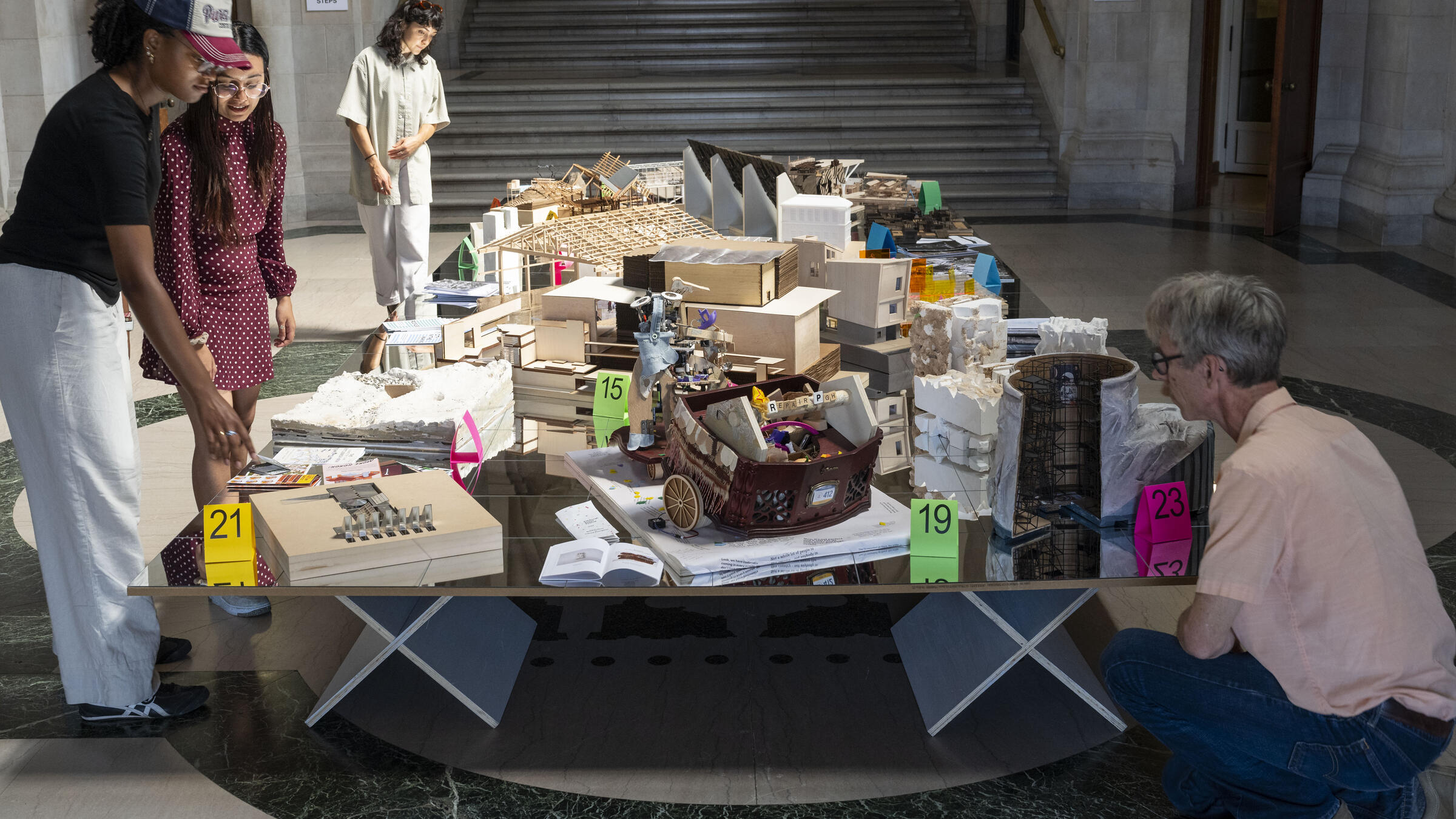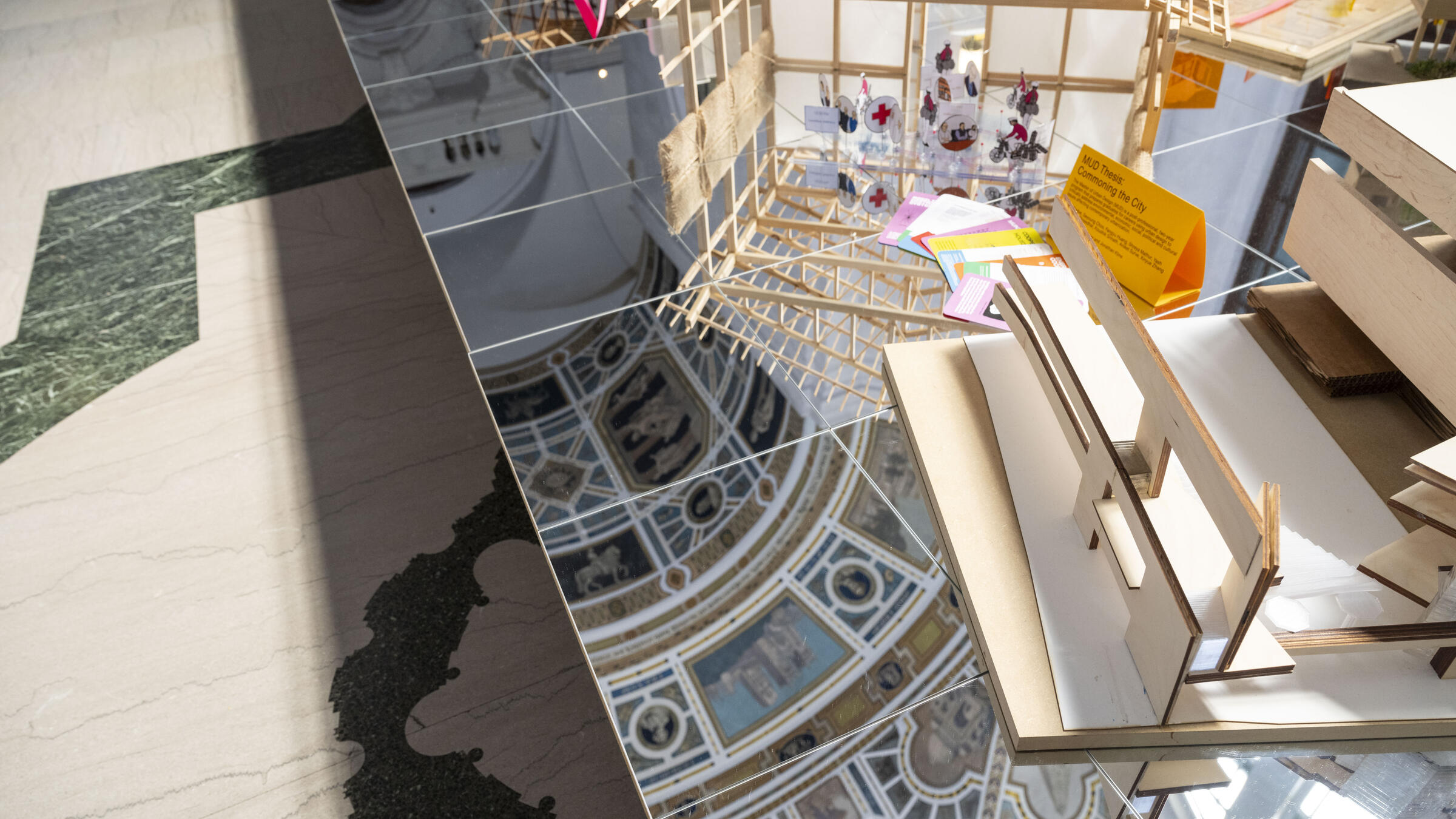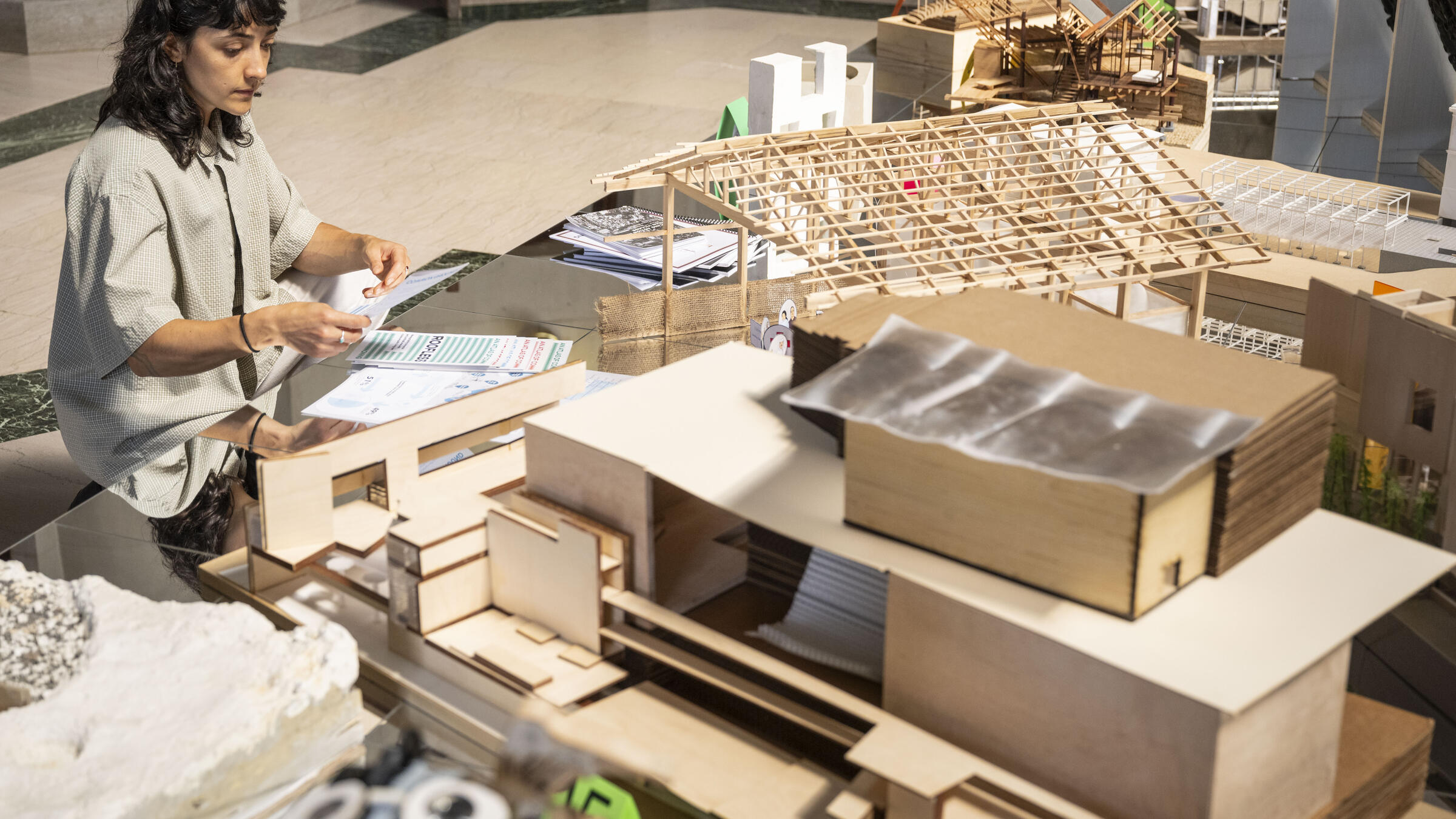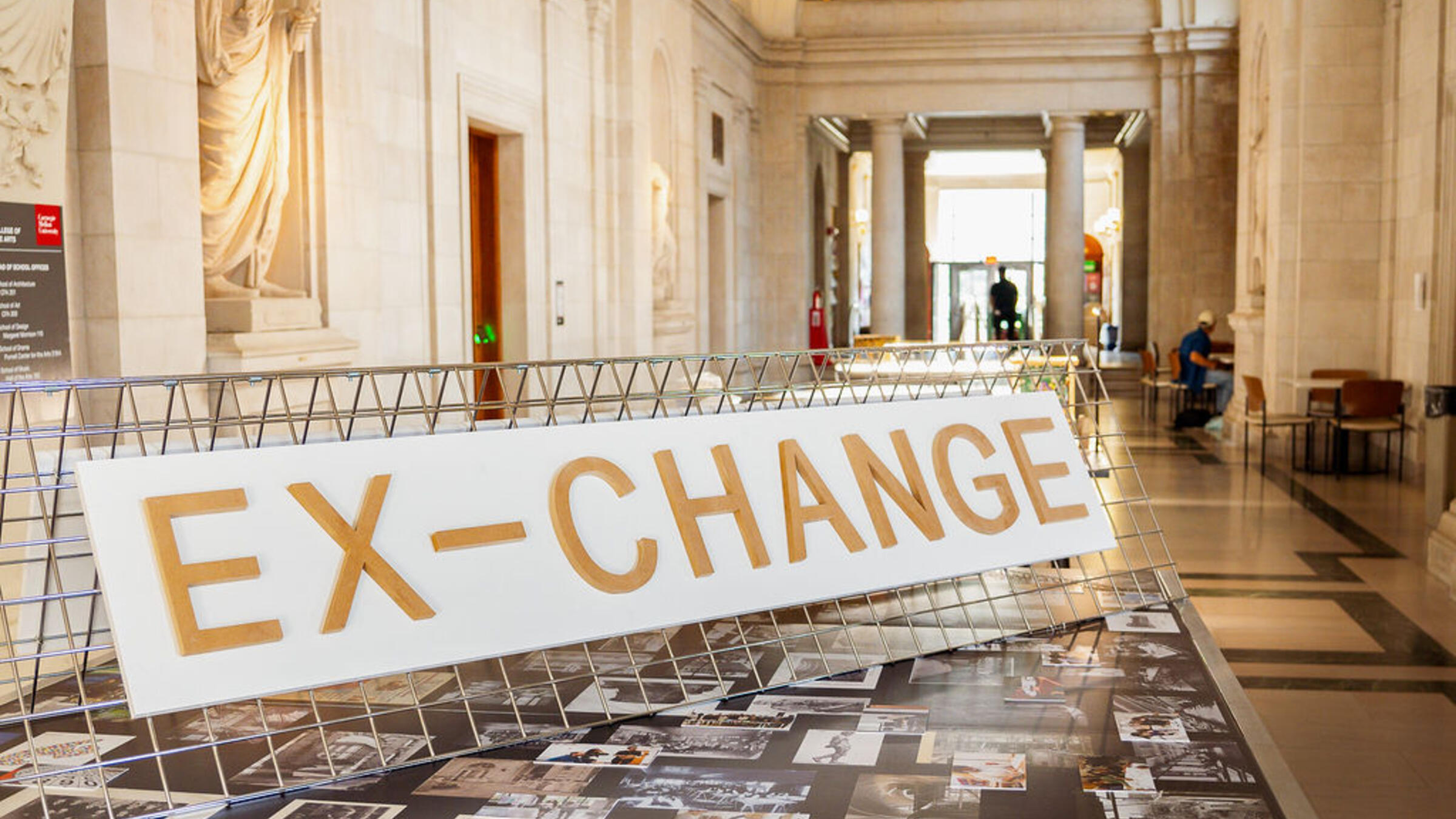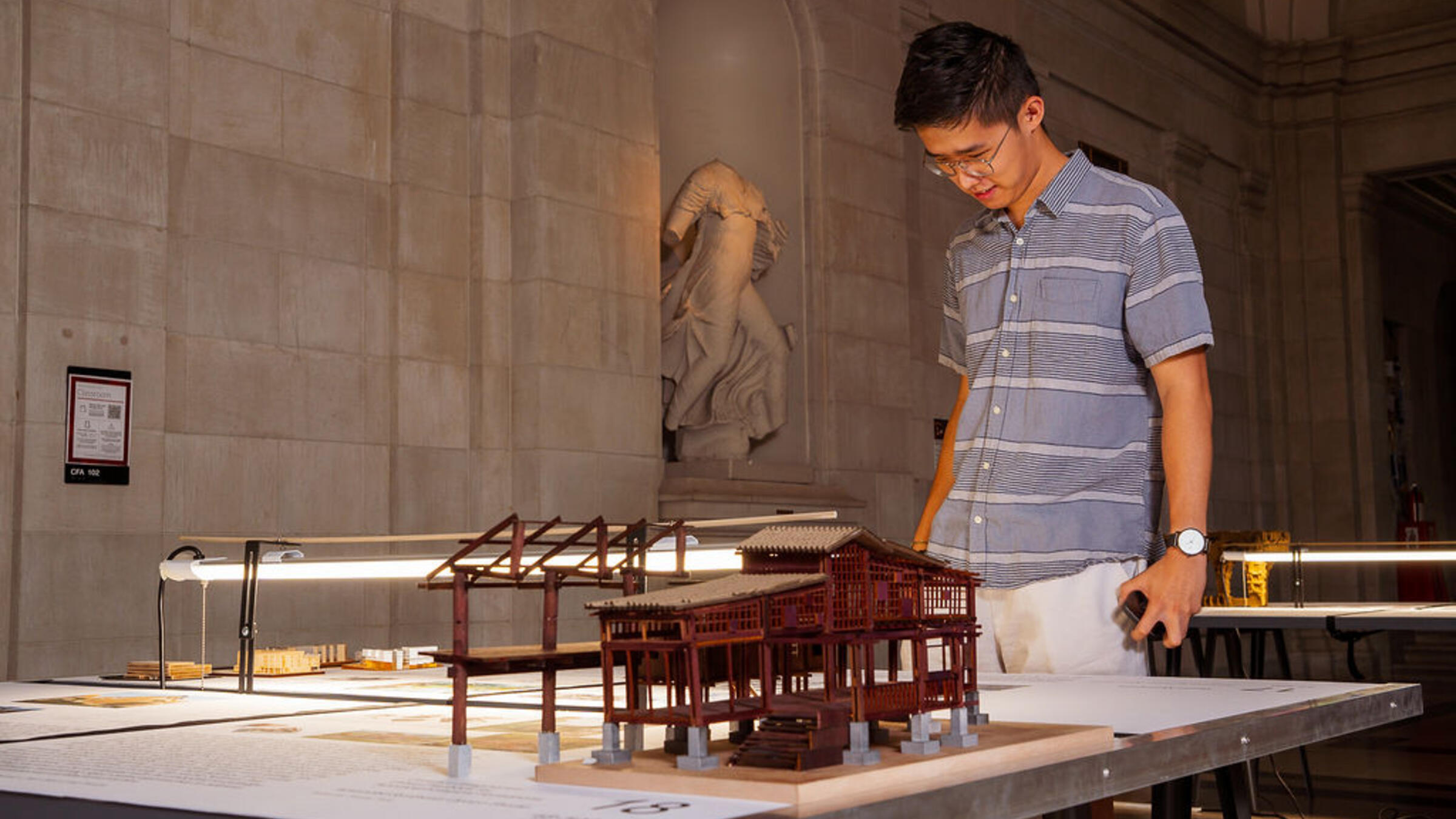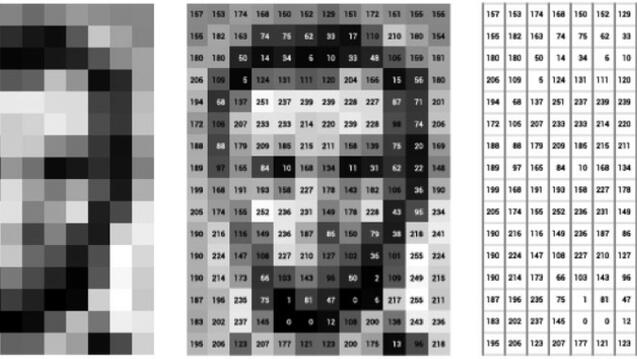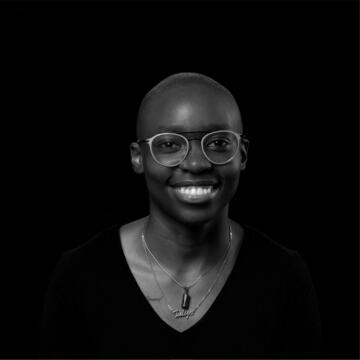e-SPAN Newsletter v034: Artificial (and Othered) Intelligences
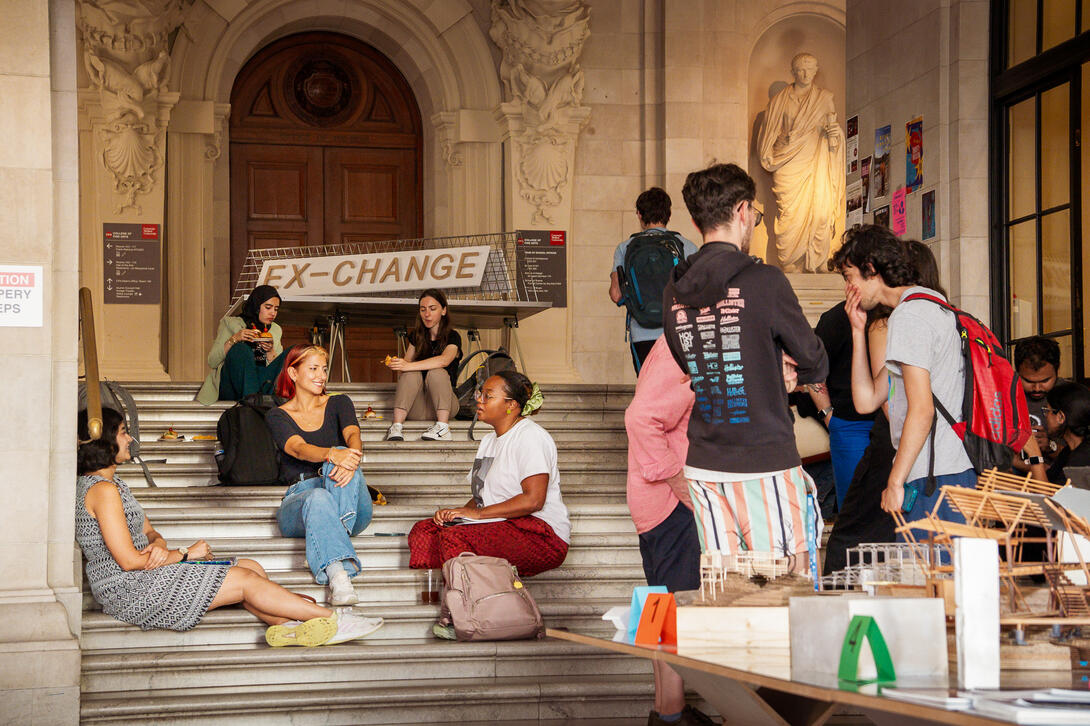
Dear School of Architecture Community,
We are excited to start the 2024-25 academic year, especially to meet our new classes of students and new faculty colleagues joining us from New York, Toronto, Iowa, Miami and further afield. We eagerly await the work they will make with us this year.
We began the new year with a celebration of last year’s extraordinary work. Phillip Denny (B.Arch ’14) designed this year’s EX-CHANGE catalog (request your copy) with its corresponding exhibition, which took on a magical spatiality in the CFA Great Hall. Models appeared to grow out of the emblematic course and studio descriptions, bringing fresh insight to the agenda for each class. The mirrored surface of the show’s table of contents in the lower level of the Great Hall suggested that the ceiling vaults and imagery of Henry Hornbostel were implicated in the speculative and propositional work of the models. The student and installer team worked wonders with fantastic direction from Sarah Rafson, Tuliza Sindi, Meredith Marsh and Christi Danner. This is a truly collaborative success story. We all have had investment in the work exhibited, whether from a casual conversation during its making, or from wrestling with the design process through its long gestation through the year.
The range of work evident in EX-CHANGE is impressive, and the different agendas that the studios and courses address position the School as a space to respond to the large questions of the moment. In that vein, the School is set to host the 2024 AIAS Northeast Quad Conference Oct. 31-Nov. 3 with the theme “DES[AI]GN: Artificial Intelligence in Architecture.” Our students are well aware that there is an enormous shift underway with how information and design tools operate, and I am heartened to see them take up the topic of AI and bring light to its ethical challenges. With their fresh and fearless energy, the students’ questioning of these new conditions will be important to watch. The School includes AI as one of our three pedagogical challenges alongside climate change and social justice, and this newsletter will address the challenges and opportunities of AI throughout this academic year, beginning with an introduction to Daragh Byrne’s involvement in the development of a research and pedagogical response to AI at the College level.
Carnegie Mellon Architecture is fortunate in its partnership with the Heinz Architectural Center (HAC) at the Carnegie Museum of Art (CMoA), which this semester hosts graduate students studying history and theory through the HAC collection with curator and faculty colleague Theo Issaias. The HAC is also hosting the major exhibition City of Rooms, curated by Raymond Ryan, featuring the work of the Mexico City practice Tatiana Bilbao ESTUDIO. On view now through June 15, 2025, the show questions domesticity and our everyday use of space. Also at the CMoA, the School is exhibiting at the second annual Pittsburgh Art Book Fair (PABF), an event capturing a creative crosscurrent which is very much alive in Pittsburgh. As co-sponsors of the event with the School of Art and School of Design, our booth will feature the EX-CHANGE publication and printed works from faculty and students, including the student publication inter•punct, amid a wealth of experimentation and invention on view in the Hall of Sculpture from Sept. 28-29.
We look forward to a great year ahead and hope to see you at one of our events this fall if you are in Pittsburgh. Welcome to all!
Mary-Lou Arscott, AADip, RIBA
Associate Head of Design Fundamentals
Associate Studio Professor & Associate Head for Design Fundamentals
2024 EX-CHANGE Exhibition
Anyone familiar with Carnegie Mellon knows that it has engaged in artificial intelligence (AI) research since the field’s advent — and the College of Fine Arts (CFA), of which Carnegie Mellon Architecture is a part, is no exception.

But in the past couple of years, as esoteric, experimental AI research has rapidly leapt into the mass market, it has become clear that CFA needed to change its approach to pedagogy and research around AI.
The CFA AI Working Group
In response to AI’s sudden ubiquity, CFA Dean Mary Ellen Poole formed a working group of faculty and staff to define a distinctly CFA approach to teaching, research and creative practice with AI.
Associate Teaching Professor Daragh Byrne leads this task force, working to support students’ and faculty’s interaction with AI in a way that’s creative, skillful and ethical.
The CFA working group’s chief activities include growing baseline knowledge and support around the ever-shifting world of AI research and products, designing foundational experiences and courses for both students and faculty, and making AI tools an accessible resource for everyone in the College.
The AI Up-skilling Fund for CFA faculty and staff, inaugurated this past spring, elicited a competitive collection of applications from faculty and staff members seeking to craft and offer new instructional and creative experiences for students. Architecture faculty Azadeh Sawyer and Tommy CheeMou Yang are among the eight faculty and staff across CFA selected for funding. Their work will help augment Carnegie Mellon Architecture’s approach to AI, both for students and faculty.
AI in the Academy: What is Academia’s Role?
Practicing architects scrambling to keep pace with lightspeed changes in the tech landscape may well wonder how academia can keep up, let alone lead the way, in conversations about AI.
After a year with the CFA working group, Byrne is excited about academia’s role, which he describes as “driving the conversation across institutions.” He cites an event held this past spring, Creativity, Empathy and AI: A National Summit on The Human-AI Creative Partnership, co-hosted by Carnegie Mellon, Virginia Tech, Penn State and a2ru (The Alliance for the Arts in Research Universities). Seventy-five delegates from across the academy, industry and policy convened in Washington, DC to discuss the current state of AI in the arts, how it will change the fine and applied arts, and how to best position all stakeholders to engage with it mindfully.
The summit wasn’t an ivory-tower affair: academic representatives were joined by industry leaders, policymakers and union representatives to understand AI’s effects in the workforce. Higher education, said Byrne, can play an important role in connecting these dots, ensuring a smooth educational arc from K-12 all the way through undergraduate and graduate school, and into the professional space.
“Industry is great at moving quickly to get tools out into the world,” said Byrne. “We in the academy are great at critically interrogating, unpacking and understanding the implications of that. We can bring knowledge and wisdom to the processes of toolmaking, education and practice.”
High-Level Themes in Learning to Work with AI
Throughout this academic year, Carnegie Mellon Architecture’s e-SPAN Alumni Newsletter will focus on the construction and deployment of that knowledge and wisdom at the School. Byrne is keeping one eye on the practicalities — how AI tools are used in studio courses, for example — and the other on fundamental themes underlying this rapid change:
It’s all new, but architects and designers are already well trained to work in shifting contexts.
Even researchers who’ve been in this field for decades are learning as they go. But design practitioners are no strangers to massive shifts in their technological landscape. Their resilience amidst change will remain crucial as AI reconfigures design work.
The way we work will be reshaped, but many underlying principles will remain unchanged.
Byrne resists one-to-one comparisons between AI and, say, the invention of photography or parametric modeling tools. But he acknowledges a key similarity: AI will radically change the way architects and designers work, and even how they think about work. “Tools shape thinking,” he said, “so what it means to be creative will probably change: the ways we think, where we spend our effort and time. We’ll cultivate different sensibilities, competencies, skills and communication methods. We in the academy are reckoning with and carefully attending to the fact that we’re training students for a different work experience in the near future.”
“In the CFA working group,” said Byrne, “we understand that we must embed in these new competencies the same ethical and responsible frameworks we always have. We must think, for example, about the communities most harmed and affected by AI and how to address this through architecture and design practice.”
This is what Carnegie Mellon Architecture is perfectly positioned to do, said Byrne: “respond to these urgent and pressing dilemmas — but do it rigorously, thoughtfully and with care.”
Artificial Intelligence in Our Pedagogy
This fall, Carnegie Mellon Architecture is offering a course that introduces students to the use of AI tools in design. Taught by Visiting Assistant Professor Jimmy Wei-Chun Cheng, the course is foundational to the School's growing pedagogy in AI.
This course integrates computer vision and generative AI for students in architecture, urban design, sustainable design and related fields. It covers fundamental image processing and generative AI concepts like generative adversarial networks (GANs) and diffusion models.
Fall 2024 Public Programs: Artificial (and Othered) Intelligences
Psychologist Howard Gardner* famously argued that intelligence should be thought of in the plural: intelligences. Beyond the eight intelligences he identifies, architects and designers leverage many more forms of intelligences and wisdoms in their practices and ways of being: from material intelligences, Indigenous, mythological and more-than-human, just to name a few.
At a university with a history of groundbreaking development of artificial intelligence, Carnegie Mellon Architecture’s 2024-25 Public Programs invites architects, scholars, designers and artists to think about intelligence in their work and the things they design as they are confronted with the many blind spots that come with innovation, and the frictions and zones of negation that emerge when a multiplicity of intelligences attempt to co-exist.
The series of lectures and workshops aims to explore how interdependent views across intelligences might best serve our futures as we ask: how do we rethink our processes as a result of evolving ideas of intelligence, and to what ends?
* Gardner, H. (1993). Multiple intelligences: the theory in practice. Netherlands: Basic Books.
View Fall 2024 public programs schedule
Welcoming Tuliza Sindi as Curator for Public Programs and Director of Publications
After an international search conducted over the summer, Tuliza Sindi has been appointed Curator for Public Programs and Director of Publications at Carnegie Mellon Architecture.
Sindi is an architecture educator, researcher, practitioner and curator based between the U.S. and South Africa. She founded the graduate design-research studio Unit 19 (2020-22) at the University of Johannesburg’s Graduate School of Architecture (GSA) and held the 2023-25 Ann Kalla Professorship in Architecture at Carnegie Mellon Architecture.
In 2022, she co-founded cross-disciplinary architecture collective room19isaFactory. with three Unit 19 graduates. Through the typological practice she terms “Unreasonable Architecture,” she attempts to suspend design approaches to “land” as defined by modern reason, chronopolitics and property regimes through the practice of architecture as cosmological wall-making.
Curator for Public Programs and Director of Publications & Special Faculty
Join us this Weekend at the Pittsburgh Art Book Fair!
Now in its second year, the Pittsburgh Art Book Fair (PABF) takes place this weekend on Saturday and Sunday, Sept. 28 and 29, in the Hall of Sculpture at the Carnegie Museum of Art (CMoA). We will be exhibiting with the student group inter·punct and celebrating the launch of the 2024 EX-CHANGE publication. We are co-sponsoring the event along with the CMU Schools of Art and Design, which will also be exhibiting all weekend. If you're in town, stop by and say hello!
Retirements
- After 15 years at Carnegie Mellon Architecture, Don Carter has retired. Don was a Senior Research Fellow with the Remaking Cities Institute (RCI) at Carnegie Mellon University and a consultant to Campus Design and Facility Development. Don previously served as the David Lewis Director of Urban Design and Regional Engagement of the RCI. Prior to joining CMU in July 2009, Don was President of Urban Design Associates in Pittsburgh where for over 36 years he led many of the firm’s most complex projects, drawing upon his broad international experience as an architect, urban designer and developer. Don was also an alum of our Bachelor of Architecture program.
- Nina Baird has retired from CMU. She was an Assistant Teaching Professor at Carnegie Mellon Architecture and Co-Chair of Carnegie Mellon University's Green Practices Committee. Nina’s courses explored the dynamic interactions between buildings and the environment. She challenged students to think creatively and critically about improving building performance to support environmental and human health. Her courses combined technical understanding and measured performance assessment with an eye towards new technologies and better integrated solutions.
CFA Dean's Council
The College of Fine Arts (CFA) Dean’s Council convenes for its annual in-person meeting on Friday, Sept. 27. Members include alumni as well as parents of current and former students. Carnegie Mellon Architecture is represented by Goil Amornvivat (B.Arch ’96), Mark Chambers (B.Arch ’01), Helen Deller (past parent), Mark Ferguson (B.Arch ’78), Jim Halpern (B.Arch ’81), Bhupesh Patel (B.Arch ’93), Jake Ploeger (current parent), Janice Watson (past parent), Yumiko Yamada (B.Arch ’99) and Rachel Zsembery (B.Arch ’01). They represent the interests of the School of Architecture among those gathered from across CFA.
Alumni News & Updates
We invite all Carnegie Mellon Architecture alumni to keep us up to date on their awards, professional milestones and more. Send us your updates with a brief description and link to more information.
- We mourn the passing of Michael McDonnell, AIA (B.Arch ’90), who passed away peacefully at his home on July 22, 2024, at the age of 59, surrounded by family after a long battle with cancer. Mike was a gifted designer, mentor and leader in his many roles including Principal and Chief Operating Officer at IKM Architecture; dedicated member of the American Institute of Architects (AIA), serving as a past President of the Pittsburgh Chapter; and as an active member of the Upper St. Clair community, where he advised on several township boards. Read the full obituary.
- The AIA elevated alumni John B. Lape, III, FAIA, FCSI, FCSC (B.Arch ’73) and Kent Suhrbier, FAIA, LEED AP (B.Arch ’92) to the College of Fellows during the AIA Awards Gala on June 7, 2024, at the National Building Museum in Washington D.C. during AIA24.
- Alumni Eli Green (B.Arch ’00), David Kunselman, AIA (B.Arch ’90) and Laurence Qamar (B.Arch ’85) are featured in the fall 2024 issue of the College of Fine Arts Magazine.
- Green is the founder and director of SQFT Studios. Based in Portland, Ore., the firm specializes in custom and prefabricated accessory dwelling units (ADUs), as well as remodeling and custom home building with a strong focus on environmental sustainability.
- Kunselman is the director of capital development for the City of Seattle, and Qamar owns and operates his own architecture and urbanism firm in Portland, Ore. Although they have different jobs, they share a common goal when building communities: value the residents who will live there, as well as the local culture, heritage and natural environment.
- A short film by Nouf Aljowaysir (B.Arch ’16) was featured in the New York Times Op-Docs: “I Asked A.I. Where It Thought I Was From. Its Answer: Nowhere.” Aljowaysir is a visual artist and technologist whose work examines the underlying logic of AI systems from a personal and intimate lens.
- Joseph Pell Lombardi, alum of the Bachelor of Architecture program at Carnegie Tech in the 1960s, was featured in the New York Times article “The 84-Year-Old Visionary With One Answer for Two Real Estate Crises.” A celebrated historic preservation architect, Lombardi completed the first office to residential conversion in New York City.
- A pen and ink drawing titled “Echoes of Empathy” by Anum Shah (B.Arch ’16), Staff Architect at SK+I Architecture, has been selected to show internationally in Dubai next summer at the Northeast Ismaili Arts Festival.
